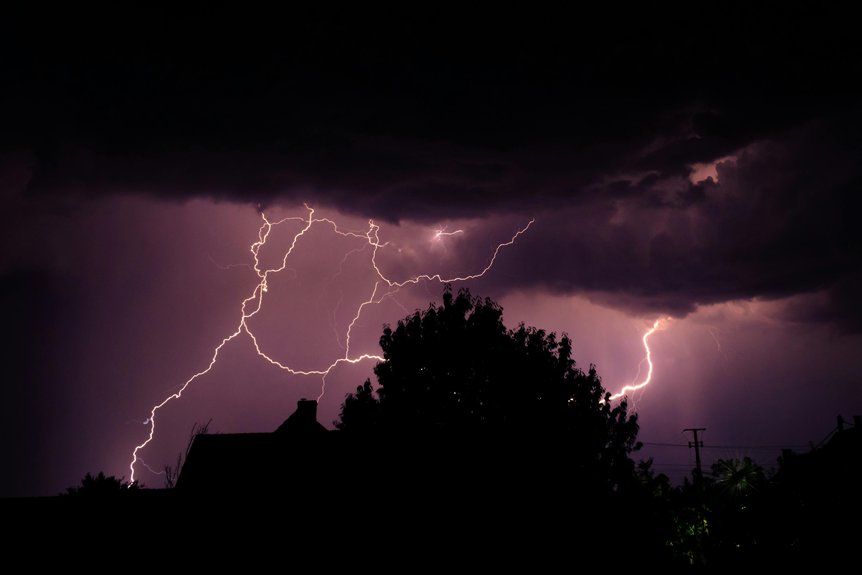When replacing your roof, paying attention to roof flashing is essential for protecting your home. Proper flashing directs water away from vulnerable areas, preventing leaks and structural damage. Skipping or installing low-quality flashing can lead to costly repairs down the line. Understanding how to choose and install the right flashing makes a significant difference in your roof’s durability. Keep going to learn why this small detail can have a big impact on your home’s safety.
Understanding Roof Flashing and Its Functions
Roof flashing is a crucial component that helps protect your home from water leaks and damage. It’s a thin metal material installed around roof joints, chimneys, vents, and skylights to direct water away from vulnerable areas.
Without proper flashing, water can seep into your roof structure, causing rot, mold, and costly repairs. Flashing works by sealing gaps and preventing water from penetrating beneath shingles or tiles.
Its durability and correct installation are essential for long-term protection. Regular inspections ensure flashing remains effective, especially after storms or high winds.
Understanding its role helps you appreciate the importance of maintaining and replacing flashing when needed. If you suspect any issues, contacting Top View Roofing for a free inspection can help protect your home from further damage.
Common Areas Where Flashing Is Essential
Certain areas on your home are particularly vulnerable to water infiltration, making flashing essential for protection. These include roof valleys where two slopes meet, as water naturally flows down and can seep through unprotected gaps.
Chimneys and vents also require flashing to seal the junction between the roof and the structure, preventing leaks. Skylights and dormers are additional areas where flashing helps direct water away from openings.
Without proper flashing in these critical spots, water can penetrate your roof, leading to damage and costly repairs. Ensuring flashing is correctly installed in these areas keeps your home dry and protects your investment.
Risks of Neglecting Proper Flashing Installation
Neglecting proper flashing installation can greatly increase your risk of water damage, leading to costly repairs and structural issues. Without correctly installed flashing, water can seep into vulnerable areas around chimneys, vents, or roof joints.
Over time, this moisture causes wood rot, mold growth, and deterioration of roofing materials. Water intrusion can also weaken your roof’s support system, risking leaks inside your home.
Additionally, neglecting flashing can void roof warranties, leaving you responsible for repairs. Overall, improper installation substantially raises the likelihood of long-term damage, making proper flashing not just a detail but a crucial safeguard for your roof’s integrity.
Materials Used for Roof Flashing
Choosing the right materials for roof flashing is essential to guarantee durability and effective water protection. Common options include aluminum, copper, galvanized steel, and vinyl.
Aluminum is lightweight and resistant to rust, making it a popular choice for many roofs. Copper offers excellent longevity and aesthetic appeal but comes at a higher cost. Galvanized steel provides strength and affordability but may corrode over time if not properly coated.
Vinyl flashing is budget-friendly and easy to install but less durable. Your choice depends on your climate, budget, and the specific roof area.
Selecting the appropriate material assures your flashing performs well and lasts for years.
Best Practices for Installing Roof Flashing
To guarantee your roof flashing performs effectively, proper installation is crucial. Start by thoroughly cleaning the area to remove debris and ensure a secure bond.
Measure and cut the flashing accurately, allowing for overlaps of at least 2 inches to prevent leaks.
Secure the flashing with corrosion-resistant nails or screws, placing them along the edges and avoiding the center.
Seal all seams and overlaps with high-quality roofing sealant to prevent water infiltration.
Make certain the flashing is installed flush against the roofing surface, with no gaps or wrinkles.
Properly installed flashing directs water away from vulnerable points and extends your roof’s lifespan.
Long-Term Benefits of Proper Flashing Maintenance
Maintaining your roof flashing properly offers significant long-term benefits, including preventing costly repairs and extending your roof’s lifespan. When you regularly inspect and address minor issues, you keep water from seeping into vulnerable areas, avoiding leaks and structural damage.
Proper maintenance also guarantees your flashing remains effective against weather elements, reducing the risk of rust and deterioration. Over time, this saves you money on repairs and replacements.
Additionally, a well-maintained roof preserves your home’s value and keeps your property safe. Consistent upkeep of your flashing is a smart investment that pays off by maintaining your roof’s integrity and protecting your home for years to come.
Conclusion
In summary, roof flashing is crucial for protecting your home from water damage and extending your roof’s lifespan. Proper installation and maintenance prevent costly leaks and structural issues over time. By paying attention to flashing details during your roof replacement, you guarantee a durable, weather-resistant roof that keeps your investment safe. Don’t overlook this essential component—prioritize quality flashing to enjoy long-term peace of mind and a secure, leak-free home. For more information on how to schedule your free roof inspection, call us at (405) 543-2920 or visit us online at Top View Roofing.

